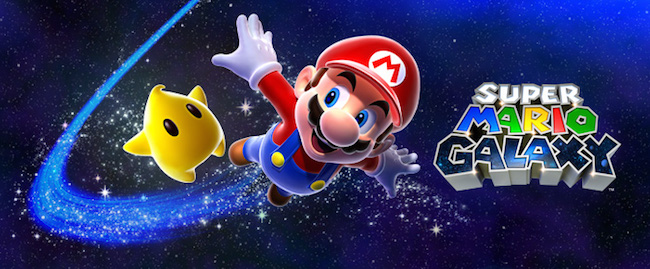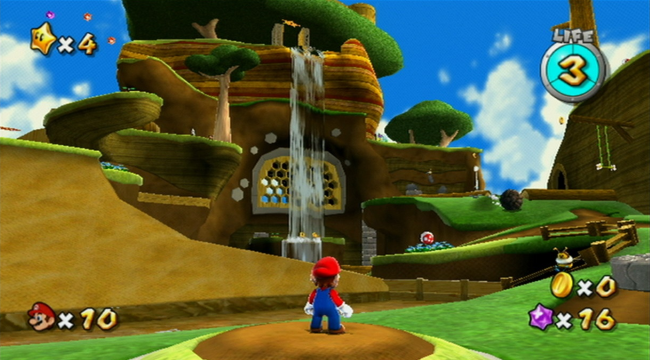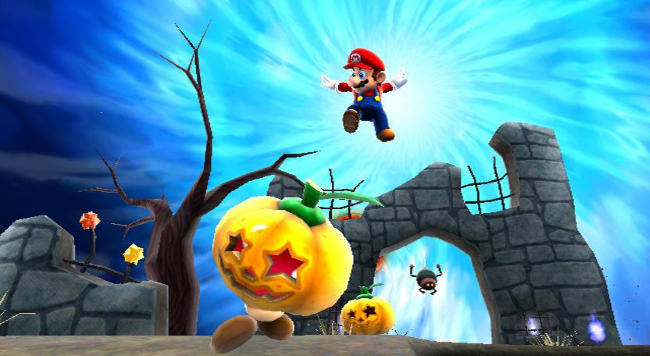
Editor Note: If you’re not familiar with the term “pile of shame”: basically, it’s all the games you’ve purchased over the years but never gotten around to playing. We’re working our way back to retrospectively review some of ours!
Everything is cooler in space. I mean, just look at Star Wars, Halo, Metroid, or that series of Power Rangers where they were in space for some reason. So why not take Mario and put him up there? It’s a good thing Nintendo managed to ignore the abundance of answers to that question because Super Mario Galaxy is a game as innovative as it is classic. After years of playing every sport, this is the game that proves there isn’t much Mario can’t do; except protect the Princess, I guess.

You’ll never guess what happens in Super Mario Galaxy: this big crazy turtle-dragon guy kidnaps a Princess and Mario has to save her by completing levels! Oh, you guessed that? This time Bowser takes Peach up into space, and Mario comes across a nice lady by the name of Rosalina. She possesses an observatory/spaceship that can take Mario to his special one; just so long as he collects the power stars to fuel it. Classic Mario stuff, but there are loads of little things that keep the story interesting as you shoot through the cosmos. Rosalina will tell you her tale in storybook form if you choose to listen, Captain Toad and his Toad Brigade will help you out with the Power Stars, and Luigi will need your help from time-to-time.
There is so much charm and character throughout, that the ‘story’ never feels unimportant. There are people/penguins/bees/trash-guys to talk to on most of the planets Mario visits, and their interesting and memorable character designs encourage you to chat with them. Quick, pop-up dialogue boxes mean there’s never a reason not to talk to somebody; you won’t have to stand still, mashing A until they leave you alone. There’s an unmistakably Zelda-like quality to it all, but it’s kept short and sweet to adapt perfectly to a Mario game.
More important than the people he meets, is all the new stuff Mario can do in space. For starters, gravity does a lot more than keep you on the ground in Super Mario Galaxy. It keeps you on the walls, on the bottom of rocks, sling-shotting around giant marbles, rolling on a glass ball through a twisting maze made of lava floating in complete desolation, whatever. It’s a gimmick, to be sure, but the beauty of it is that it isn’t overused. Sometimes you’ll be jumping between tiny planetoids, sometimes you’ll be exploring a larger environment in the vein of Super Mario 64. Alternating between these two distinctly different types of level means you never get tired of either. On the other hand, both rely on the same platforming prowess, so they never feel disconnected from one another. The impact of gravity might be the most noteworthy aspect of Super Mario Galaxy’s mechanics, and levels are designed to show this off just the right amount, but it certainly wouldn’t struggle without them.

Mario jumps, spins and… shoots? I never hear about how Super Mario Galaxy successfully incorporated first-person shooting into a traditional platformer. Sure, it’s pretty much completely optional, but you can point at the screen to aim and shoot a Star Bit at any time. You don’t need to do it, but it’s the best way to deal with certain enemies or pick up some secret coins. The Wii Remote functionality goes beyond that, too. Using motion controls to blow Mario around in a bubble, pull him towards little blue stars or steer a space-manta ray sound about as shoehorned as it gets – they’re not. As important as motion controls are to SMG, they feel like the ideal method of input for every single use. Even shaking the Wii Remote to make Mario spin is satisfyingly immersive, without ever becoming annoying or tiresome.
The conventional controls are perfect too. Moving gets a bit more complicated than usual when you’re walking all around a planet; going straight and to a side becomes going back-forward and upside-down-left. Surprisingly though, it doesn’t take much getting used to. Everything controls so intuitively that walking upside down, or in a spiral or anything feels comfortable and easy. The camera works just as well. Though controlling it can be fairly limited, the game does a great job of keeping the camera where it needs to be. Seeing as there’s no second stick any camera problems would be especially annoying, but I never had a single issue. Sunshine must be feeling pretty jealous by now.
The sheer variety of gameplay is tremendous. Any game that can incorporate diverse styles of play and retain a solidarity to this extent is awesome in my eyes. There are pretty traditionally styled platforming situations, there are races, there are more puzzle oriented levels, there’s everything. Contributing to this diversity are the power-ups and the comets. Power-ups can turn Mario into a bee, a spring, a ghost, or an ice-man who freezes all water that he touches. Certain power-ups run on a timer, so using them becomes a timed challenge, while others deactivate when Mario comes into contact with water. Comets add an extra challenge to a planet; racing “Cosmic Mario” to a certain point, collecting purple coins, or beating a boss without being hit. It’s a great way to make the player replay a level without feeling like they’re repeating themselves, and it was always fun.

Super Mario Galaxy is a perfect example of the type of video game structure I love. Each planet has a certain amount of stars to be earned within it, and earning stars unlocks new planets to visit. It’s completely possible to skip the levels you’re not a fan of and earn all of your stars from the ones you do like. It takes 60 to beat the game, while there are 120 in total; plenty of wiggle room. In my retrospective review of Super Mario Sunshine, I talked about how I felt no inkling to strive for 100% completion – this was a different story. Every single level is so wonderfully fun that after collecting every last power star I was still having just as much fun as I was right at the beginning of the game. If you need a reward, reaching 100% allows you to replay the whole thing as Luigi, with a bit of a bonus at the end for doing it all twice.
It’s hard to see how the Wii was criticized so heavily for its visual capabilities with this as an example. Super Mario Galaxy came out in 2007, and it still looks amazing. So many beautiful, vibrant worlds, smooth, Pixar quality character models, and even a great looking HUD all make SMG look great. Seven years and a console generation later, and Super Mario Galaxy is one of the greatest looking video games I’ve ever had the joy of playing. It just goes to show how far brilliant design can go, even without a powerful system backing it up.
The soundtrack was perhaps the most surprising part of SMG for me. Sure I didn’t expect it to be bad, but I didn’t expect it to be what it is, either; phenomenal. This was the first fully orchestrated Mario game. As extravagant as an orchestra might seem for a plumber who jumps on things, it’s only fitting for such an epic game. Ranging from huge sweeps to mellow string melodies, every piece of music fits like a beautiful, silky glove.
Super Mario Galaxy is a game about kicking an evil turtle around an entire planet, feeding star-people until they explode, and flying across beautiful solar systems. It’s silly at its core and not much about it makes sense, but it’s wonderful just the same. Perfect controls, so much to do, stunning worlds, and a fantastic score launch Mario Galaxy into the highest rank of video games. Super Mario Galaxy is one of the most fun, best looking, best sounding, and all around best games I have ever played.











